Institute for Cosmic Ray Research, The University of Tokyo
Division of Science, National Astronomical Observatory of Japan
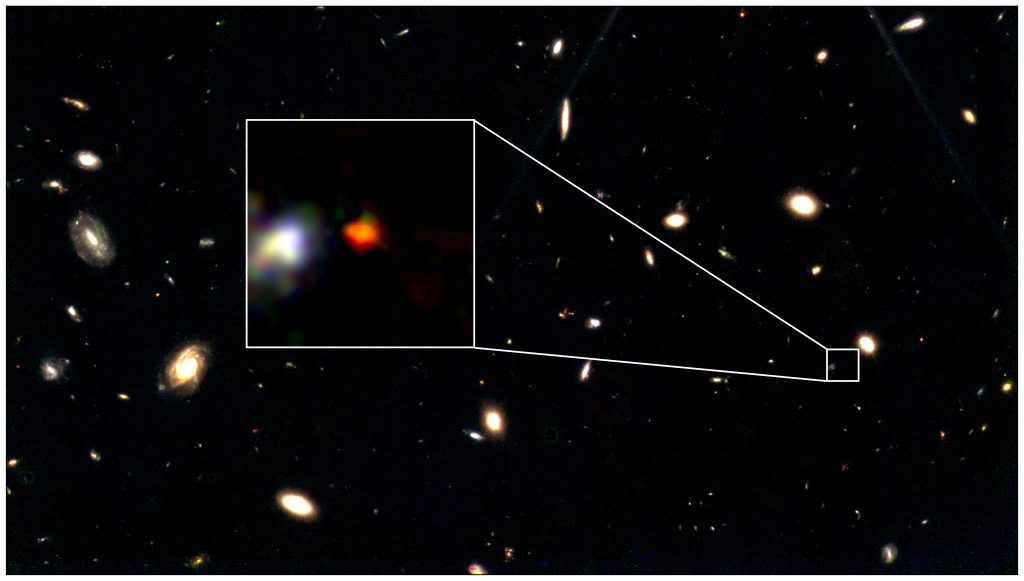
(Credit: NASA, ESA, CSA, Harikane et al.)
The research team led by Yuichi Harikane (Assistant Professor at the Institute for Cosmic Ray Research, the University of Tokyo) successfully measured the precise distance of two bright galaxies located 13.4 billion light-years away in the universe, using spectroscopic observation data from the James Webb Space Telescope (see Figure 1). In the most distant universe spanning 13.4 to 13.5 billion light-years, only three galaxies had been confirmed previously, leaving uncertainty regarding whether these findings contradicted theoretical predictions or not. With this confirmation of two additional galaxies by the team, now the number of confirmed galaxies has surpassed any prior theoretical predictions made before the launch of the James Webb Space Telescope, indicating an active star formation within a short period in the early universe. This result presents the possibility that a formation process for early galaxies, including the primordial ones, differs from previously believed theories for galaxy formation.
The universe was born around 13.8 billion years ago with the Big Bang, and the subsequent formation of the first stars and the first galaxies occurred a few hundred million years later. This era, when the universe was transformed from the dark state to state with the first object formation illuminating the universe, is known as the “cosmic dawn.” It represents the last frontier yet to be explored in the 13.8-billion-year history of the universe, garnering significant attention of astronomers. Especially, when the first galaxies form and what are the properties of them remain shrouded in mystery and is a major goal in modern astronomy. To investigate these primordial galaxies, astronomers have tirelessly sought galaxies in the distant universe, further back in time. Despite extensive exploration using large telescopes such as the Subaru Telescope and the Hubble Space Telescope, only a handful of galaxies existing in the early universe, prior to 13.4 billion years ago, have been found, and their precise distances remained unclear. This challenge stems from the fact that the wavelength of the light emitted by galaxies from over 13.4 billion years ago has stretched due to the universe’s expansion, shifting into the infrared spectrum, where previous large telescopes cannot conduct sensitive observations.
The James Webb Space Telescope, launched on the Christmas 2021 (December 25) and beginning its full operation last summer, is breaking new ground and revolutionizing astronomical research. Its primary objective is observing galaxies in the early universe. Leveraging the largest mirror among space telescopes, a 6.5-meter diameter, the James Webb Space Telescope achieves sensitivity in the infrared wavelength 10 to 1000 times higher than other telescopes, enabling the discovery of numerous candidate galaxies from as far back as 13.4 to 13.6 billion years ago. However, these objects are candidates for distant galaxies discovered from images, and determining their precise distances necessitates detailed analysis through spectroscopic observations. For instance, CEERS-93316, reported as a galaxy candidate from 13.6 billion years ago last summer, was later determined through spectroscopic observations to be a galaxy from 12.6 billion years ago. Such cases underscore the indispensable role of spectroscopic observations in accurately determining distances in the exploration of the most distant galaxies.
The team led by Harikane deeply analyzed spectroscopic observational data obtained through the James Webb Space Telescope. They successfully detected an oxygen emission line and hydrogen absorption with high precision (at a significance of over 99.9999%) from two candidates for galaxies dating back 13.4 billion years (Figure 2), determining their precise distances as 13.40 and 13.42 billion light-years, respectively (Note 1). Harikane, leading the research team, expresses their excitement at that time: “Thanks to the high sensitivity of the James Webb Space Telescope’s observations, we detected not only hydrogen absorption commonly observed in early galaxies but also the oxygen emission line with remarkable accuracy from galaxies dating back 13.4 billion years, successfully measuring the precise distances to these galaxies. The moment I summarized the these findings, it felt like witnessing an unexplored universe that humanity had not yet reached, and it was incredibly exhilarating.” Kimihiko Nakajima (assistant professor at the National Astronomical Observatory of Japan), responsible for processing the spectroscopic data within the research team, explains the significance of this study: “Previous studies of the most distant galaxies were mostly based on candidates found from images, but there was always concern about the uncertainty in determining the distance to these galaxies. This research, based on spectroscopic observations providing accurate distances, allows for discussions with higher reliability compared to previous studies, presenting immensely significant scientific value.”
In the most distant universe, 13.4 to 13.5 billion light-years away, three galaxies had previously been confirmed through spectroscopic observations, with uncertainty prevailing regarding whether these findings contradicted theoretical predictions. With the addition of two new galaxies confirmed by the teram, a total of five galaxies have now been identified in the early universe, dating back approximately 300 to 400 million years after the Big Bang. The discovery of these five galaxies was not predicted in any theoretical models published before the launch of the James Webb Space Telescope (Figure 3). Harikane expresses his astonishment, stating, “Before the launch of the James Webb Space Telescope, large telescopes like the Subaru and Hubble were used to study distant galaxies, and their results were well explained by various theoretical models. However, the discovery of these five galaxies in the most distant universe by the James Webb Space Telescope was unexpected in any of those theoretical models!”
Additionally, the research team investigated the rate of star formation based on the brightness of galaxies. They found that in the universe 13.4 to 13.5 billion years ago, the rate of star formation is over four times higher than predicted by models, implying that stars are being born at a much faster pace than anticipated (Figure 4). This result suggests a possibility that the process of galaxy formation in the early universe, including the first galaxies, might differ from previously believed theories. Masami Ouchi, a professor at the University of Tokyo Institute for Cosmic Ray Research and the National Astronomical Observatory of Japan, explains, “These observational findings indicate the existence of some mechanism in the early universe that actively triggers the birth of stars, challenging the long-held theories of star and galaxy formation that we have maintained for years. Alternatively, these five galaxies might shine brightly due not to stars but due to the activity of supermassive black holes. In that scenario, it would imply the existence of supermassive black holes in the early universe, posing significant questions about the birth and growth of black holes.” He continued, “Which of these possibilities is correct cannot be determined solely based on the observations obtained so far. This will certainly be one of the most important topics to be studied with future observations by the James Webb Space Telescope.”
Through this study, it has become clear that in the most universe, stars are forming more vigorously than predicted by theoretical models, illuminating the era of the cosmic dawn. It is possible that even the first galaxies also hosted active star formation. Besides this finding, the James Webb Space Telescope has also succeeded in detecting an rapid increase of oxygen, nitrogen-rich galaxies, and the discovery of numerous supermassive black holes in the early universe. Summarizing these findings Harikane concludes, “Thanks to the remarkable capabilities of the James Webb Space Telescope, unanticipated objects and phenomena have been discovered in the distant universe. Humanity is now on the brink of reaching the formation epoch of the first galaxies. We’re witnessing a revolution in astronomy. I feel fortunate to live in an era where such a revolution is taking place and aspire to continue contributing to the expansion of humanity’s intellectual horizons through research.”This research was supported by KAKENHI (20H00180, 21J20785, 21K13953, 21H04467) through Japan Society for the Promotion of Science, JSPS Core-to-Core Program (grant number: JPJSCCA20210003), and the World Premier International Research Center Initiative (WPI Initiative), MEXT, Japan.
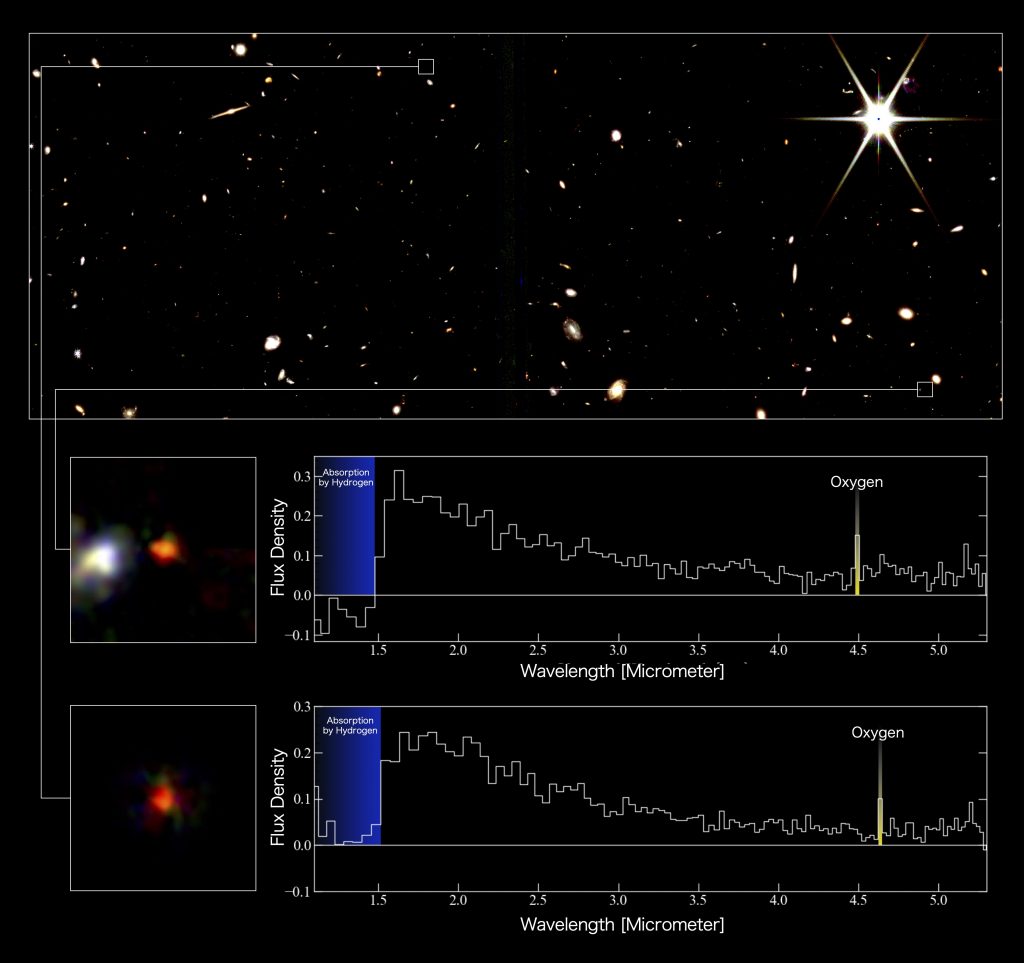
(Credit: NASA, ESA, CSA, Harikane et al.)
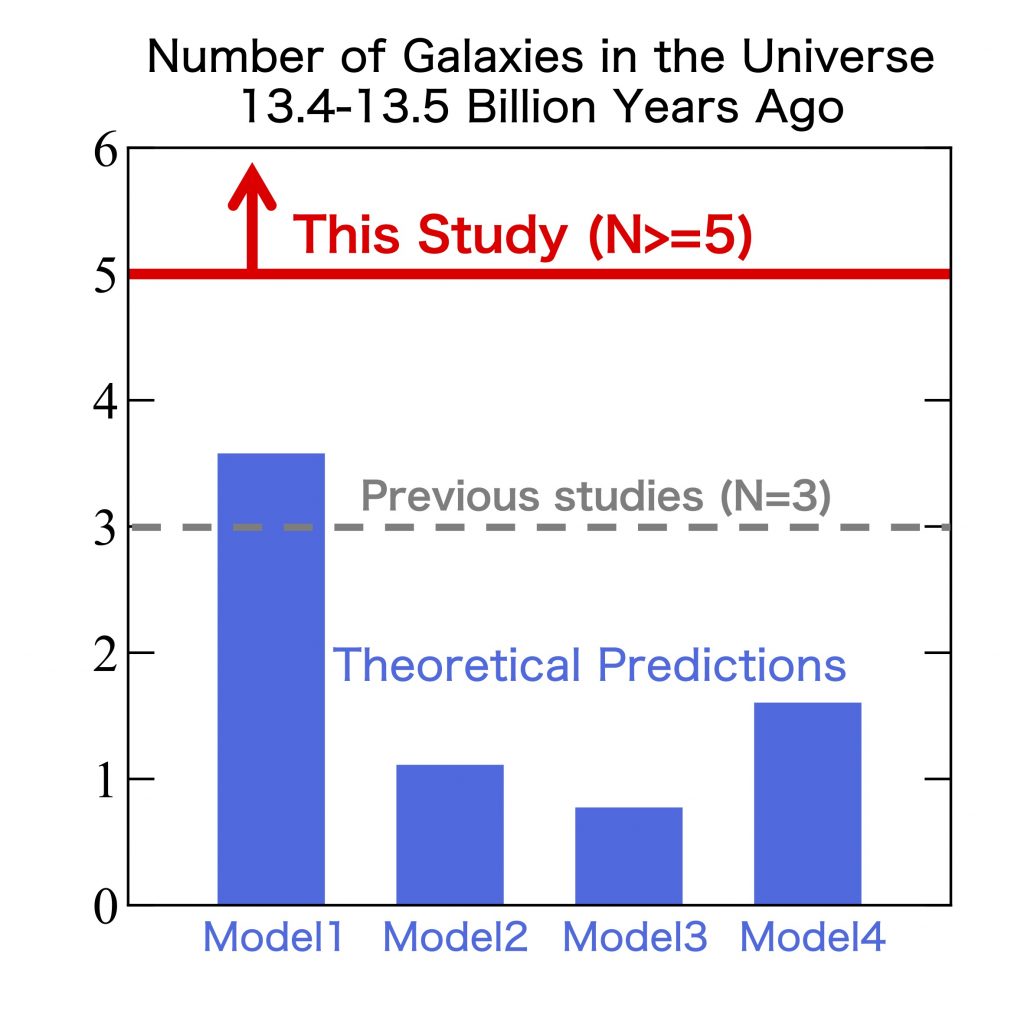
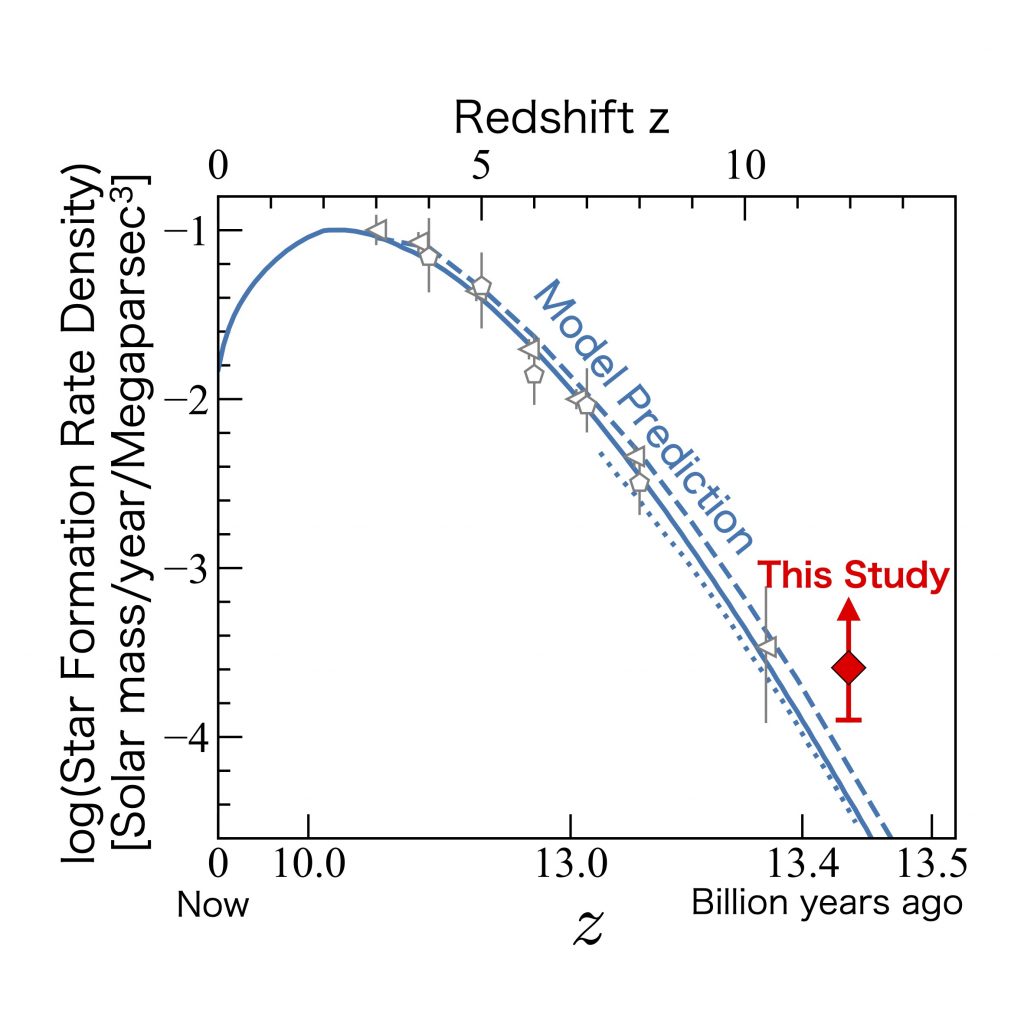

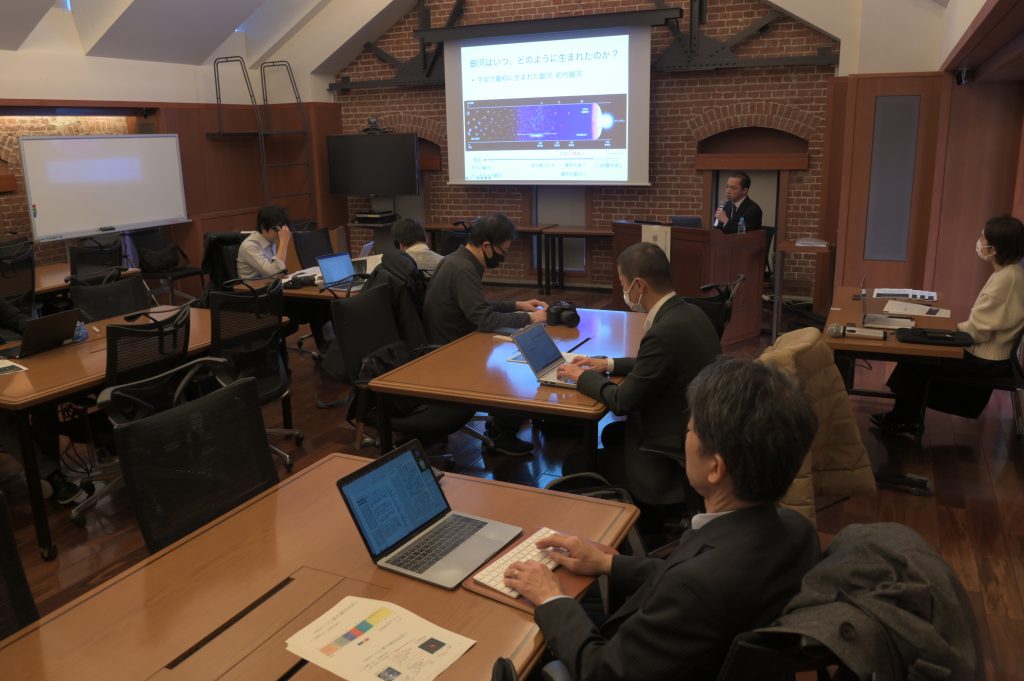
= This photo was taken at Conference Room of Ito International Research Center in UTokyo Hongo Campus at about 14:00 (JST) of December 22
Notices
(Note 1) The redshifts of the two galaxies, precisely determined by detecting the emission line of oxygen and the absorption due to hydrogen, are z=11.04 and 11.40, respectively. Redshift is a metric used to represent cosmological distances. Using cosmological parameters from the Planck observation team announced in 2015 (“Planck 2015 results. XIII. Cosmological parameters”, “TT,TE,EE+lowP+lensing+ext” in Table 4; H0 = 67.74 km/s/Mpc, Ωm=0.3089, ΩΛ=0.6911), calculating distances from redshift yields 134.0 billion light-years and 134.2 billion light-years for these galaxies, indicating their existence around 13.4 billion years ago. However, due to the expansion of the universe, the distance between us and these galaxies at present is over 13.4 billion light-years.
(Note 2) Until now, oxygen has been detected within galaxies using telescopes such as ALMA and the James Webb Space Telescope. However, the results from this study (redshift z=11.04, 11.40) mark the confirmation of the most distant oxygen within galaxies, surpassing all previous records.
(Note 3) The observed hydrogen absorption is caused by neutral hydrogen between a galaxy and us, known as the Lyman Break. Light of shorter wavelengths than 0.12 micrometers is absorbed by neutral hydrogen, resulting in distinct dips in the galaxy’s spectrum. With a redshift of z=11 for these objects, the Lyman Break appears around 1.5 micrometers in the observed wavelength.
Information
〈Journal〉 The Astrophysical Journal
〈Title〉 “Pure Spectroscopic Constraints on UV Luminosity Functions and Cosmic Star Formation History From 25 Galaxies at zspec=8.61-13.20 Confirmed with JWST/NIRSpec”
〈Authors〉 ✳Yuichi Harikane, Kimihiko Nakajima, Masami Ouchi, Hiroya Umeda, Yuki Isobe, Yoshiaki Ono, Yi Xu, and Yechi Zhang
〈DOI〉 10.3847/1538-4357/ad0b7e
〈URL〉 https://iopscience.iop.org/article/10.3847/1538-4357/ad0b7e
Presentors
Institute for Cosmic Ray Research, The University of Tokyo (Astrophysics and Gravity Research division)
Yuichi HARIKANE Assistant Prof.
Masami OUCHI Prof.
&:National Astronomical Observatory of Japan Prof.
Hiroya UMEDA Doctoral course
Yuki ISOBE Doctoral course
Yi Xu Doctoral course
Yoshiaki ONO Assistant Prof.
Division of Science, National Astronomical Observatory of Japan
Kimihiko NAKAJIMA Specially appointed assistant prof.
Yechi Zhang JSPS research fellowship for young scientists





